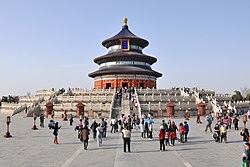Temple of Heaven
| Temple of Heaven 天壇 / 天坛 |
|
|---|---|
|
UNESCO world heritage |
|

|
|
| Hall of Harvest Prayer in the northern district of the Temple of Heaven |
|
| National territory: | China |
| Type: | Culture |
| Criteria : | (i), (ii), (iii) |
| Surface: | 215 ha |
| Buffer zone: | 3,155.75 ha |
| Reference No .: | 881 |
| UNESCO region : | Asia and Pacific |
| History of enrollment | |
| Enrollment: | 1998 (session 22) |
The Temple of Heaven or Heaven Altar ( Chinese 天壇 / 天坛 , Pinyin Tiantan ) is a temple complex in Beijing , where the emperors of the Ming and Qing -Dynastien every year praying for a good harvest. It has been included in the UNESCO World Heritage List .
investment
The facility is located in the former Chongwen district in the south of the city in the middle of a large park. The entire facility is surrounded by a kilometer-long double wall. In the northern part of the complex, the walls have a round floor plan, while the southern floor plan is square. Seen from above, the wall plan looks like an elongated dome. This shape comes from the idea that the sky is round and the earth is square. The double wall around the entire complex, at a distance of several meters, creates an inner and an outer area of the temple. The main buildings of the facility are located in the inner area. The inner area is also divided by a wall and thus forms a northern and a southern part of the temple.
In the northern part is the most important building of the temple precinct, the "Hall of the Harvest Sacrifice" ( 祈年殿 , qíniándiàn ), also called the "Hall of the Harvest Prayer " ( 大 祈 殿 , dàqídiàn ). The 36 meter wide and 38 meter high rotunda has a circular floor plan and stands on a three-tier marble terrace ( 圓 丘 / 圜丘 , yuánqiū - "circular hill"). This approximately 20 meter high terrace base has similarities with the Central American step temples . The hall was built by Emperor Yongle in 1420 , burned down in 1889 and was rebuilt in 1890 and is a landmark of Beijing. This northern area was mainly used as an altar in spring to pray for the harvest.
In the southern part is the second large building, the "Hall of the Heavenly Vault " ( 皇 穹 宇 , huángqióngyǔ ), a smaller, also circular temple hall. It is surrounded by the "echo wall" ( 回音壁 , huíyīnbì ), an absolutely smooth and exactly circular wall. Due to its round shape, sound waves are guided along the wall and can be perceived everywhere on the wall. So if you speak against the echo wall, you can even hear what was said at the opposite point. This principle is known in Europe as the whisper vault , in castles and monasteries also as a whisper niche.
The southern hall, together with the three-tier marble terrace, which it has just like the northern part, served as an altar during the winter months.
The marble terrace and the north and south hall are on a north-south axis in the center of the entire complex. The halls are connected by the 360 meter long Danbi Bridge ( 丹陛 橋 / 丹陛 桥 , dānbìqiáo ). This bridge therefore connects the northern and southern parts of the facility. The entire temple axis with terrace and halls is 1200 meters long and is flanked by old trees. According to the company, this makes the Temple of Heaven the longest facility for heavenly worship in the world.
meaning
The temple was added to the UNESCO World Heritage List in 1998. In the justification for the inclusion, UNESCO describes the importance of the facility in three criteria: The Temple of Heaven as a masterpiece of architecture and landscape design was important for the development of Chinese culture, its design had a strong influence on other East Asian cultures, and it symbolizes legitimation the Chinese feudal rule of over 2000 years.
See also
Web links
- Entry on the UNESCO World Heritage Center website ( English and French ).
- Himmelstempel.de
- Five annotated photos
Individual evidence
- ↑ a b c UNESCO World Heritage Center: Temple of Heaven: an Imperial Sacrificial Altar in Beijing. Retrieved March 29, 2017 (English).
Coordinates: 39 ° 52 ′ 56.2 ″ N , 116 ° 24 ′ 24.5 ″ E




